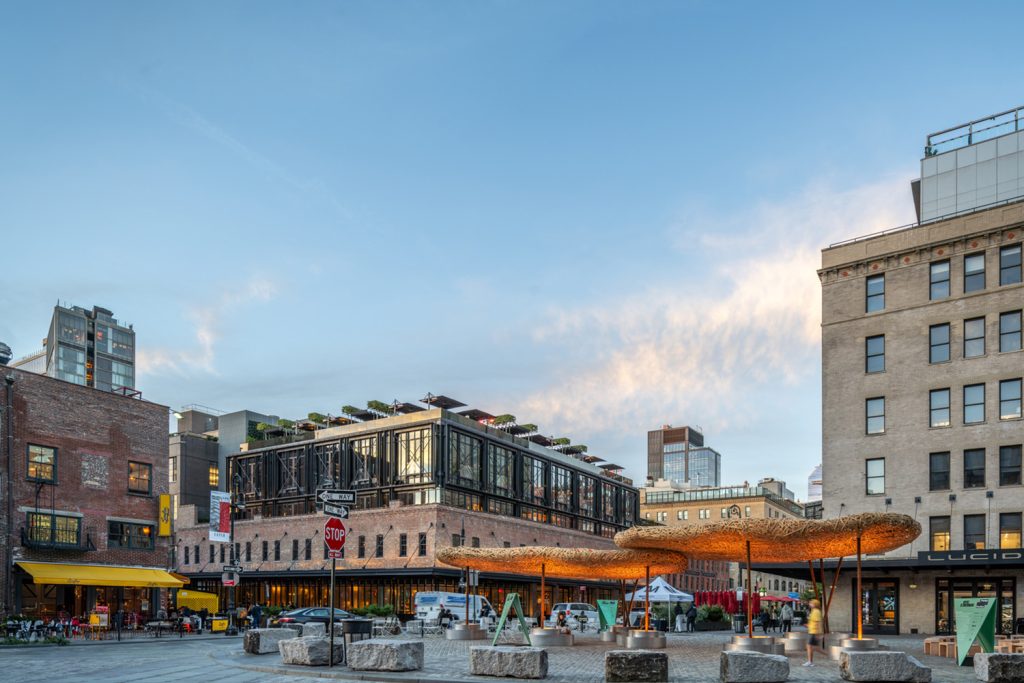Bamboo Cloud breaks geographical and material boundaries with its assembly method

This year’s Design Pavilion for NYCxDESIGN featured Bamboo Cloud, an experimental installation created and built by Shanghai-based architecture company llLab. The lightweight structure appeared to be floating over Gansevoort Plaza, located in New York‘s Meatpacking District, from 12-18 October during Archtober 2023.
The exhibition’s theme was “Open To The Sky.” The idea behind the design was to maximize the effect of the woven bamboo while also disguising the structure while making the floating bamboo clouds the most lightweight form of expression. Bamboo, a multifunctional and environmentally friendly material, has been used in architecture for millennia. This resilient resource, primarily used in Asian and African locations, has been used for an infinite number of architectural applications. The Bamboo Cloud is built on this long legacy of bamboo building.


Bamboo Cloud’s overall creative and construction concept attempts to overcome this inherent limitation by employing a method of assembly that allows it to cross geographical and material boundaries, bringing natural consciousness and natural space to previously inaccessible areas, such as here, like a mass of fibers floating over New York City. For execution, it can still only be compared to wood in the role of “engineered bamboo” in terms of both structural calculation and material qualities. The Bamboo Cloud, on the other hand, aspires to unify natural bamboo and engineered bamboo with regard to materials and uses, as well as their qualities and physical appearance.
To obtain maximum coverage, the main truss format is restricted by the interior dimensions of the shipping container. With the designers’ concept of using bamboo, the typical use of rods and nodes of the truss structure and the triangle-shaped sub-frame becomes quite inconsistent and contradictory in terms of the material physical properties. As a result, the manufacture of bamboo truss structure reversed the typical logic of truss nodes and rods, combining the two to generate a waveform with many arcs bending and linking each other. The bamboo’s material qualities can also be continuous in the structural plane and in the direction in which they are directed because of the interlocking joint between the “waves.”

To prevent stress concentration, all points of contact have been extended to the surficial layer. This can aid in the uniform distribution of pressure. Simultaneously, to optimize the “disappearing structure” effect, the weaving process is executed without any dependence on the structure, with bamboo strips serving as the primary structural element for the weaving portion of the bamboo clouds. The 120 square meter bamboo cloud space is made up of 12 main trusses, 16 auxiliary trusses, and 10,000 bamboo strips.
In order to maximize efficiency, the design process looked into performance extremes. Bamboo is the most organic building material, and it is also used in areas other than construction. Bamboo strips smaller than 5 mm thick and less than 5 cm broad are used during prototyping to evaluate the threshold for lightweight construction. A Bamboo Cloud is a porous volume composed of woven bamboo stripes. It may be implemented at the building scale because of the material’s inherent resilient force, which causes it to spontaneously find its form and eventually stable as a volumetric entity.
The Bamboo Cloud pavilion by llLab is a continuation of an earlier endeavor that was erected in Guilin, China. In that project, the studio used woven bamboo strips to build a series of canopies and livable pods that provided protection from the rain. Long before the Bamboo Cloud arrived in New York, the team at llLab was questioning traditional applications of bamboo. The team has already investigated the material’s possibilities with a comparable work, which will occupy Guilin, China’s stunning forested terrain, in 2020.

Project Info
Architects: llLab
Area: 116 sqm
Year: 2023
Architectural Design: llLab
Lighting Design: L’Observatoire Internatio
Structural Design: LuAnLu Partners Structure Consulting
Timeline: January 2022 – October 2023
Location: New York, United States
Photographs: Xi Chen + Chris King



